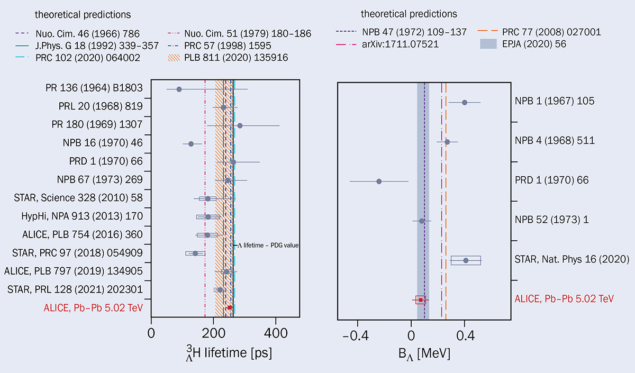A report from the ALICE experiment.

At the LHC, light nuclei and antinuclei are produced both in proton–proton and in heavy-ion collisions. Unstable nuclei, called hypernuclei, are also produced. First observed in cosmic rays in 1953, hypernuclei are formed by a mix of protons, neutrons and hyperons containing one or more strange quarks and undergo weak decays. Almost 70 years since their discovery, hypernuclei are still a source of fascination for nuclear physicists since their production is very rare and the measurement of their properties is extremely challenging.
The only hypernucleus observed so far at the LHC is the hypertriton (3ΛH), composed of a Lambda baryon (Λ), a proton and a neutron. While, traditionally, hypernuclei are studied in low-energy nuclear experiments, the hundreds of hypertritons and antihypertritons produced in each lead–lead run at the LHC provide one of the largest data samples for their study. The hypertritons fly for a few centimetres in the experimental apparatus before decaying into a 3He nucleus and a charged pion, which are then identified by the detectors.
The ALICE collaboration recently completed a new analysis of the largest Run 2 data sample, achieving the most precise measurements to date of the hypertriton lifetime and its Λ-separation energy (the energy required to separate the Λ from the rest of the hypertriton). The lifetime, measured from the distribution of reconstructed two-body decay lengths, was found to be 253 ± 11 (stat.) ± 6 (syst.) ps, while the separation energy, obtained from the hypertriton invariant-mass distribution, was measured to be 72 ± 63 (stat.) ± 36 (syst.) keV.
These two quantities are fundamental to understand the structure of this hypernucleus and therefore the nature of the strong interaction. While the strong force binding neutrons and protons inside atomic nuclei is well understood, the characteristics of the strong force binding nucleons and hyperons are not precisely known.
The study of this interaction is not only interesting per se, but it is also an input for modelling of the dense core of neutron stars. Indeed, the creation of hyperons is energetically favoured compared to ordinary nucleonic matter in the inner core of neutron stars. Therefore, detailed knowledge of the interactions between nucleons and hyperons is required to understand these compact astrophysical objects.
The new ALICE measurements indicate that the interaction between the hyperon inside the hypertriton and the other two nucleons is extremely feeble (see figure 1). This is also confirmed by the lifetime of the hypertriton, which is compatible with the free Λ-baryon lifetime. Finally, since at the LHC matter and antimatter are produced in the same amount, the ALICE collaboration could compare the lifetimes of the antihypertriton and the hypertriton. Within the experimental uncertainty, the lifetimes were found to be compatible, as expected from CPT invariance.
During LHC Run 3, ALICE will extend its studies to heavier hypernuclei, putting tighter constraints on the interaction models among hyperons and nucleons.
Further reading
ALICE Collab. 2022 arXiv:2209.07360.





